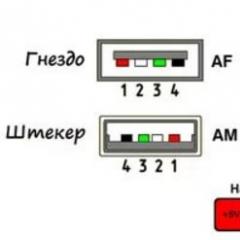Ten services that allow you to send self-destructing emails. Self-deleting messages One-time messages
One of the most demanded features of modern digital technologies is their ability to store information forever. But, at the same time, it is also a big problem, especially when it concerns living people.
Not all users like that any of their photo, tweet, social network status or message Email can be stored in a database for decades, and then they will be born at the most inopportune time. Therefore, in recent years, there has been an increasing demand for services that allow you to work with "one-time" information, that is, with such data that disappear without a trace after the time or event you specified. Some of these services will be discussed in this article.
Photo and video
snapchat
It's special mobile app(iOS, Android), which is used to share photos and videos. You can clearly define the recipients of your picture or clip, as well as set the time of their availability from one to ten seconds. The message you sent is then deleted from both the recipient's device and the Snapchat servers.

secret.li
Secret.li is a handy iOS app that gives you more control over your Facebook photos. The application allows you to specify who can view photos. You can also set the self-destruct time for snapshots. The developers promise to soon introduce a version for Android.
Tweets
This is a free web service that allows you to send self-destructing tweets after a specified time. You must give access to your Twitter account, after which the service will be able to control your tweets using special hashtags. View Hashtag #20m means that this tweet will be deleted after 20 minutes. In the same way, you can set other time intervals using the letter d for days and h- for hours.

Instant messaging
Wickr
Application for Android and iOS that allows you to send text messages, pictures, audio and video files using encryption. In addition, all the data you transmit may have a self-destruct function, which allows you to delete it without a trace after a few seconds, hours or even days. There is even protection against screenshots so that overly cunning acquaintances do not try to save your messages as pictures.

mxHero Toolbox
mxHero is a Chrome extension that improves the functionality of Gmail. In order to protect your correspondence, it is able to convert letters into pictures that disappear after a time specified by you. We wrote about this extension in .

This is another way to send a one-time message to a person. Only in this case the text of the message will be published on the page of the service, and you will send the addressee only a link to this page. After reading the message, it is destroyed and the link automatically becomes invalid.

Summing up, we can say that in light of the ever-increasing pressure on user privacy, the response will naturally grow. This means that many of the developments described in the article may well count on popularity and further development.
Do you like the eternal life of the content you generate in the digital universe?
One-time links can be used in a variety of situations: to provide temporary access to a file or page, or to confirm registration. In this tutorial, we'll show you how to generate and implement disposable URLs.
Creating a URL
Suppose we have a user authentication system on the site. After registration, we ask the user to go through the email verification procedure. To create such links, we can use the special token parameter. An example of such a link:
http://example.com/activate?token=ee97780...
We cannot do without a database here, so let's look at the table we will work with.
CREATE TABLE pending_users (token CHAR(40) NOT NULL, username VARCHAR(45) NOT NULL, tstamp INTEGER UNSIGNED NOT NULL, PRIMARY KEY(token));
We will store 3 fields in the table: token, username and time. To generate a token, we will use the sha1() function, which produces a string of 40 characters. The tstamp field will store the time the token was generated so we can keep track of expired links.
There are many ways to generate a token, but in this tutorial we will use the uniqid() and sha1() functions. Regardless of how the token is generated, make sure that the generated values are different and the chance of duplicates is minimal.
$token = sha1(uniqid($username, true));
The uniqid() function takes a string as a parameter, and returns a unique identifier based on the passed argument and the current time. Also, as the second argument, given function takes a boolean value that will signal uniqid to add a few extra characters to increase the chance of the value being unique. The sha1 function takes a unique identifier and creates a hash.
After these two functions work, we will have a unique token that we can use to generate url addresses. Now we need to add it to the database:
$query = $db->prepare("INSERT INTO pending_users (username, token, tstamp) VALUES (?, ?, ?)"); $query->execute(array($username, $token, $_SERVER["REQUEST_TIME"]));
In order for us to know which user should be activated, we will also record the user's login in the table. In an example more adapted to a real site, you can use the user ID.
Now that we have all the information we need, we can create a temporary url:
$url = "http://example.com/activate.php?token=$token";
$message =<< Now we need a script, thanks to which we will carry out the check. All we need to do is compare the token from the url and the token from the database. If there is one, and its lifetime has not expired, then everything is OK. // get token if (isset($_GET["token"]) && preg_match("/^(40)$/i", $_GET["token"])) ( $token = $_GET["token"] ; ) else ( throw new Exception("token is not valid."); ) // check token $query = $db->prepare("SELECT username, tstamp FROM pending_users WHERE token = ?"); $query->execute(array($token)); $row = $query->fetch(PDO::FETCH_ASSOC); $query->closeCursor(); if ($row) ( extract($row); ) else ( throw new Exception("the token is not valid."); ) // activate the user account // ... // remove the token from the database $query = $db- >prepare("DELETE FROM pending_users WHERE username = ? AND token = ? AND tstamp = ?",); $query->execute(array($username, $token, $tstamp)); We also need to provide for checking for tokens that have expired: // 1 day in seconds = 60 seconds * 60 minutes * 24 hours $delta = 86400; // check if ($_SERVER["REQUEST_TIME"] - $tstamp > $delta) ( throw new Exception("Token expired."); ) // activate user account // ... Thus, we will have two checks: one for the validity of the token, the other for the duration of its existence. This method can be applied not only to activate accounts users, but also in other needs: for example, to provide one-time or temporary access to some resource or service. On top of all this, you can create a script that will remove tokens that have never been used. This script can be run by yourself from time to time or you can use cron for this. is a new feature that allows you to send self-deleting messages. And today I came across another interesting, but this time an online service called Privnote. This site allows you to send self-deleting notes for free and without registration. Who might need it? We live in the digital age. Over time, a lot of our information ends up on the web. These are both search terms and personal information in social networks, our messages on forums and websites, and of course messages saved in e-mail. After all, few people delete messages in Gmail, which offers the user gigabytes for free. The Privnote service allows you to completely destroy the transmitted information. This may be an impersonal password that you want to transfer to someone, or some other information that, as I said earlier, will not be related to your mailboxes and social networks and will not settle in the bins of your email. What if developers can view the message? I don't think they do it. You understand, each site on the network has its own goal, 99% of the sites have it in one form or another in the form of earnings. Privnote earns on Google advertising Adsense, they don't want your anonymous notes. And if the notes are depersonalized, then there is no danger at all. What does depersonalize mean? If you send a password from your mail to your partner, then you should not specify the mail itself, or do it using another service, for example, the same email. How does the Privnote site work? Everything is extremely simple, but it is better to see once than hear 100 times. Here detailed instructions for clarity. The interface of the Privnote website is translated into different languages, including Russian. As a rule, the site automatically detects the language. If this does not happen, change the language yourself. To do this, in the lower right corner in the drop-down menu, select the "Russian language" item. 1. Go to the Privnote website and type your message in the New Note field. 2. Click on the "Show Options" button. Here you can specify a password to decrypt the message, set an expiration date for the self-deleting message, and enter an email address where you can receive a read receipt when the message is destroyed. 3. After filling in all the required fields, click on the "Create note" button. Copy the link and send it to the recipient. 6. After opening the note, you will receive an email notification from Privnote. This way you will know exactly when the note was opened and read. Privnote is a pretty good service - when you try to re-enter the link and read, the message is no longer displayed, so there is no way around this. Using the default browser settings ensures that the page is not cached by the browser or any intermediate proxy servers. If you want to send self-deleting messages anonymously, then use Ten services that allow you to send self-destructing emails that automatically disappear after a certain time. Defines self-destructing email as mail message, which disappears or becomes unreadable after a certain amount of time, or at the request of the sender. Through such mail, messages can be prevented from being printed, copied, forwarded, and stored. An inappropriate email sent years ago may appear on your horizon today, just when you've decided it's probably already deleted. Self-destructing mail deletes the original message immediately after it has been read by the recipient. Although it does not provide complete protection - for example, someone can simply take a picture of a message, but at least there will be no record of it on the Internet. Listed below are a few self-destructing mail service providers that you may find useful. Some of them even offer free plugins to send emails from mail clients, such as Outlook or Thunderbird. 2.
: This site provides you with the ability to create a one-time web page for the recipient. You can safely send a message by entering the recipient's address and the text itself. The recipient will receive an email with a link to a one-time page where they can read your message only once. Immediately after the URL is used, the message is deleted. 3.
: allows you to create a message that will self-destruct after a certain number of reads, or after a period of time. 4.
: A free service that makes it easy to send, receive, retract, delete, destroy, and edit messages after they've been sent. Service users get unprecedented control over their mail, regardless of whether it is sent from the site or from the client program. 5.
: Offers features similar to the BigString service - retracting or "retracting" a message after sending, self-destruction based on the number of reads or after the passage of time, and protection against copying, forwarding and printing text by the recipient. A plug-in for email clients is currently being developed. 6.
: allows you to set the release time (Release Time), before which the letter cannot be read; time of action (Expiration Time), after which the letter cannot be read; and a "receipt of receipt" (Delivery), which indicates when, where, how and who decoded your message. 7.
: Allows you to encrypt email messages, store encrypted messages anonymously, set self-destruction options, prevent copying and forwarding. 8.
: A web service that allows you to send messages that will self-destruct after 60 seconds of browsing. 10.
: A paid service that separates the message header and who, what, and where fields from the message body. They never connect and will never be seen together. There are no records to associate service users with message content. Also, you will not be able to print, copy to clipboard, or save messages. You can be absolutely sure that after reading the letter will disappear. With their help, you can safely communicate via Email, ICQ, Skype or even Vkontakte. Principle of operation services of secret notes is simple: when you create a message, you receive a special link, which you then need to transfer to your interlocutor. When the link is opened, the message is destroyed, so the message can only be read once (similar to "burn after reading"). In the event that strangers follow the link to the message that was intended for you, then you will already know that the information has fallen into the wrong hands. On the server, messages are stored in encrypted form (usually using PGP) - this is a security measure in case the server is hacked. Is it safe? It is rather a question of trust in the administration of the service: do they really delete messages after reading and do they keep logs. With the help of the secret notes service, very valuable information can be transmitted (passwords to electronic accounts, card data, the place where the treasure is buried, etc.), which means that there is a great temptation to save it. There is also a risk that such services may cooperate with intelligence agencies. To reduce risks, you can transfer part of the information through one service of secret notes, and part through another. Or you can even create your own service with PGP message encryption - we will post instructions on how to create your own secret note service on the forum. Here's how it works in practice. Popular secret note services. privatenote.com Popular and easy to use service. Unfortunately, the service does not support the Russian language, but the sequence of actions is intuitive: we write a message in the input field, then press the button Create note, copy the received link and send it to the interlocutor (just do not follow the link yourself, otherwise the message will be destroyed). You can also check the " Notify me when this note gets read" if you want to be notified when the message is read. tmwsd.ws
The site at first glance may seem fancy compared to other similar services, but it is also easy to use: write a message, press the button SAVE THIS MESSAGE, then copy the link of the form https://⌫.ws/2wGoOvYt and pass it on to the interlocutor. The site has the ability to set a password for the message - this will protect the message from being accidentally opened or read by strangers (if the password and link are transmitted by different sources). onetimesecret.com
Examination
Outcome
How to send self-deleting messages


 5. You can read the self-deleting letter after clicking on the "Yes, show me a note" button.
5. You can read the self-deleting letter after clicking on the "Yes, show me a note" button.
25.07.2007
1.
: Allows you to send messages via webmail by appending ".self-destructing-email.com" to the recipient's address. There is also a free plugin called for email clients Outlook, Thunderbird, Opera Mail, Outlook Express and even Webmail [ ].
The service has an important feature - links to messages are generated with a special character and not all mobile browsers understand them. In this case, a link of the form https://⌫.ws/2wGoOvYt can be replaced with https://tmwsd.ws/2wGoOvYt. Links with special characters are not recognized as hyperlinks in mailers or social networks, which, on the one hand, excludes their accidental clicking, and on the other hand, complicates opening (you need to copy and paste into the address bar).
New interesting secret notes service. An important feature of this service is that when you click on the link, you still need to click on the button to read the message, which means that you won’t be able to accidentally open the secret message.
There is another strange feature - the service does not allow you to copy the text of a secret message. At first I thought that the text is displayed as a picture, which serves as an additional security measure against message interception. When I opened the source code, I saw that the ban on copying was set by styles. Why it is necessary to prohibit copying the text, in this case, is not clear, because the service can transmit data that needs to be stored on the computer, and the person, if he does not guess to look into the source code, will be forced to retype the text or save it as a screenshot.



